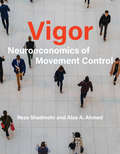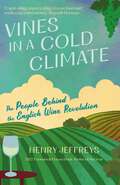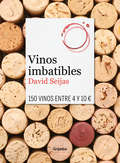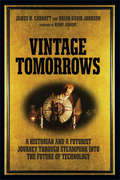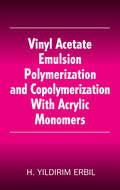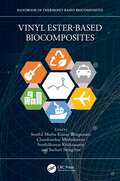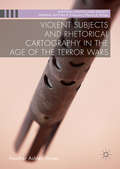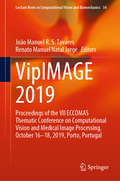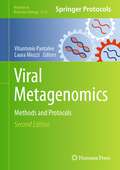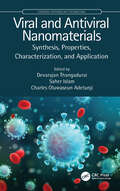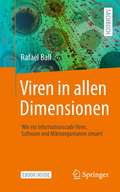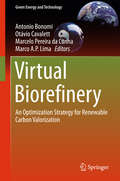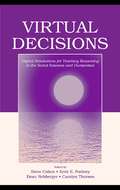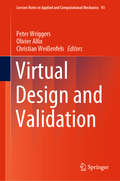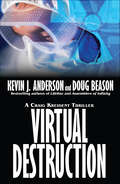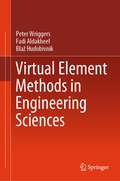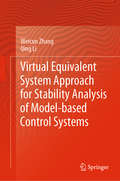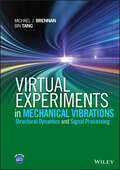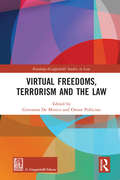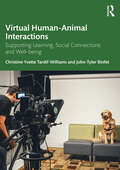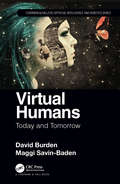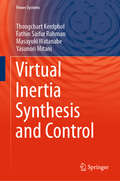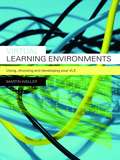- Table View
- List View
Vigor: Neuroeconomics of Movement Control
by Reza Shadmehr Alaa A. AhmedAn examination of the link between the vigor with which we move and the value that the brain assigns to the goal of the movement.Why do we reflexively run toward people we love, but only walk toward others? In Vigor, Reza Shadmehr and Alaa Ahmed examine the link between how the brain assigns value to things and how it controls our movements. They find that brain regions thought to be principally involved in decision making also affect movement vigor--and that brain regions thought to be principally responsible for movement also bias patterns of decision making.
Vilfredo Pareto: From Liberty to Science (1898–1923) (Palgrave Studies in the History of Economic Thought)
by Fiorenzo MornatiThis volume of intellectual biography takes the Italian economist, sociologist, political scientist Vilfredo Pareto (1848-1923) from his disillusionment with liberal and pacifist activism, to the original development of pure economics and the composition of his Treatise on General Sociology and the test of this latter on the war and post-war events.
Vines in a Cool Climate: The People Behind The English Wine Revolution
by Henry JeffreysThe definitive story of the extraordinary and surprising success of English wine - and the people who transformed our reputation on the global stage from that of a joke to world-class in 30 years.From an amateur affair made by retirees to a multi-million-pound industry with quality to rival Champagne, the rise of English wine has been one of the more unexpected wine stories of the past 30 years. In this illuminating and accessible account, award-winning drinks writer Henry Jeffreys takes you behind the scenes of the English wine revolution. It's a story about changing climate and technology but most of all it's about men and women with vision, determination and more than a little bloody-mindedness. From secretive billionaires to the single mother farming a couple of hectares in Kent, these are the people making wine in a cold climate.
Vinos imbatibles: 150 vinos entre 4 y 10 Eur.
by David SeijasEl prestigioso sumiller David Seijas nos presenta una selección de los 150 vinos españoles con la mejor relación calidad-precio. Tras cuatro ediciones de una guía de vinos para cada año, David Seijas propone ahora una nueva selección personal de los 150 mejores vinos españoles por su relación precio-placer. Un amplio recopilatorio de caldos para todos los bolsillos cuyos precios se mueven entre los 3# y 17#. David Seijas comparte con nosotros sus reflexiones personales vinculadas a su pasión por el vino de manera directa y desenfadada, tal como lo haría un amigo que nos recomienda el mejor vino para cada ocasión.
Vintage Moquegua: History, Wine, and Archaeology on a Colonial Peruvian Periphery
by Rice Prudence M.The micro-history of the wine industry in colonial Moquegua, Peru, during the colonial period stretches from the sixteenth through nineteenth centuries, yielding a wealth of information about a broad range of fields, including early modern industry and labour, viniculture practices, the cultural symbolism of alcohol consumption, and the social history of an indigenous population. Uniting these perspectives, Vintage Moquegua draws on a trove of field research from more than 130 wineries in the Moquegua Valley. As Prudence Rice walked the remnants of wine haciendas and interviewed Peruvians about preservation, she saw that numerous colonial structures were being razed for development, making her documentary work all the more crucial. Lying far from imperial centres in pre-Hispanic and colonial times, the area was a nearly forgotten administrative periphery on an agricultural frontier. Spain was unable to supply the Peruvian viceroyalty with sufficient wine for religious and secular purposes, leading colonists to import and plant grapevines. The viniculture that flourished produced millions of litres, most of it distilled into pisco brandy. Summarizing archaeological data and interpreting it through a variety of frameworks, Rice has created a three-hundred-year story that speaks to a lost world and its inhabitants.
Vintage Tomorrows: A Historian And A Futurist Journey Through Steampunk Into The Future of Technology
by James H. Carrott Brian David JohnsonWhat would today's technology look like with Victorian-era design and materials? That's the world steampunk envisions: a mad-inventor collection of 21st century-inspired contraptions powered by steam and driven by gears. In this book, futurist Brian David Johnson and cultural historian James Carrott explore steampunk, a cultural movement that's captivated thousands of artists, designers, makers, hackers, and writers throughout the world.Just like today, the late 19th century was an age of rapid technological change, and writers such as Jules Verne and H.G. Wells commented on their time with fantastic stories that jumpstarted science fiction. Through interviews with experts such as William Gibson, Cory Doctorow, Bruce Sterling, James Gleick, and Margaret Atwood, this book looks into steampunk's vision of old-world craftsmen making beautiful hand-tooled gadgets, and what it says about our age of disposable technology.Steampunk is everywhere--as gadget prototypes at Maker Faire, novels, and comic books, paintings and photography, sculptures, fashion design, and music. Discover how this elaborate view of a history that never existed can help us reimagine our future.
Vinyl Acetate Emulsion Polymerization and Copolymerization with Acrylic Monomers
by Yildirim H. ErbilThe versatility of the emulsion copolymerization reaction and the ability to control the properties of the final latices have led to rapid expansion both in the quantity of polyvinylacetate and vinyl acetate-acrylic copolymer latices and in their applications. Vinyl Acetate Emulsion Polymerization and Copolymerization with Acrylic Monomers provides
Vinyl Ester-Based Biocomposites
by Suchart Siengchin Senthilkumar Krishnasamy Chandrasekar Muthukumar Senthil Muthu Kumar ThiagamaniVinyl Ester-Based Biocomposites provides a comprehensive review of the recent developments, characterization, and applications of natural fiber-reinforced vinyl ester biocomposites. It also addresses the importance of natural fiber reinforcement on the mechanical, thermal, and interfacial properties. The book explores the widespread applications of natural fibre-reinforced vinyl ester composites ranging from the aerospace sector, automotive parts, construction and building materials, sports equipment, to household appliances. Investigating the moisture absorption and ageing on the physio-chemical, mechanical, and thermal properties of the vinyl ester-based composites, this book also considers the influence of hybridization, fibre architecture, and fiber-ply orientation. The book serves as a useful reference for researchers, graduate students, and engineers in the field of polymer composites.
Violent Subjects and Rhetorical Cartography in the Age of the Terror Wars
by Heather Ashley HayesThis work examines violence in the age of the terror wars with an eye toward the technologies of governance that create, facilitate, and circulate that violence. In performing a rhetorical cartography that explores the rise of the US armed drone program as well as moments of resistive violence that occurred during the Arab Spring directed at generating a counter-hegemony by Muslim populations, the author argues that the problem of the global terror wars is best addressed by a rhetorical understanding of the ways that governments, as well as individual subjects, turn to violence as a response to, or product of, the post September 11th terror society. When political examinations of terrorism are facilitated through understandings of discourse, clearer maps emerge of how violence functions to offer mechanisms by which governing bodies, and their subjects, evaluate the success or failure of the "War on Terror. " This book will be of interest to public policymakers and informed general readers as well as students and scholars in the fields of rhetoric, political theory, critical geography, US foreign relations/policy, war and peace studies, and cultural studies.
VipIMAGE 2019: Proceedings of the VII ECCOMAS Thematic Conference on Computational Vision and Medical Image Processing, October 16–18, 2019, Porto, Portugal (Lecture Notes in Computational Vision and Biomechanics #34)
by João Manuel R. S. Tavares Renato Manuel Natal JorgeThis book gathers full papers presented at the VipIMAGE 2019—VII ECCOMAS Thematic Conference on Computational Vision and Medical Image Processing—held on October 16-18, 2019, in Porto, Portugal. It discusses cutting-edge methods, findings, and applications related to 3D vision, bio- and medical imaging, computer-aided diagnosis, image enhancement, image processing and analysis, virtual reality, and also describes in detail advanced image analysis techniques, such as image segmentation and feature selection, as well as statistical and geometrical modeling. The book provides both researchers and professionals with extensive and timely insights into advanced imaging techniques for various application purposes.
Viral Metagenomics: Methods and Protocols (Methods in Molecular Biology #2732)
by Vitantonio Pantaleo Laura MiozziThis second edition volume expands on the previous edition with discussions about the latest viral metagenomics aspects covering a range of different specimens such as soil, freshwater, wastewater, fecal samples, blood plasma, clinical tissues, fungi, and herbarium samples. Chapters also look at different viral groups including archaeal viruses, eukaryotic viruses, phages, mycoviruses, and circular DNA viruses. Techniques required for studying the three viral metagenomic steps of samples processing, library construction, and analysis of data are also discussed. Written in the highly successful Methods in Molecular Biology series format, chapters include introductions to their respective topics, lists of the necessary materials and reagents, step-by-step, readily reproducible laboratory protocols, and tips on troubleshooting and avoiding known pitfalls.Authoritative and cutting-edge, Vital Metagenomics: Methods and Protocols, Second Edition is a valuable resource for researchers who are interested in learning more about this important and developing field.
Viral and Antiviral Nanomaterials: Synthesis, Properties, Characterization, and Application (Emerging Materials and Technologies)
by Devarajan ThangaduraiThis book summarizes the synthesis, properties, characterization, and application of viral and antiviral nanomaterials by using interdisciplinary subjects ranging from materials science to biomedical science. Viral and Antiviral Nanomaterials: Synthesis, Properties, Characterization, and Application highlights attainments in utilizing nanomaterials as powerful tools for the treatment of viral infections in plants, animals, and humans. It reviews the adopted strategies for designing viral and antiviral nanomaterials for medical applications, including cancer therapy and drug delivery. It also explains the different kinds of antiviral nanosized structures, their chemistries, and the attributes that enable them to be suitable targets for nanotherapeutics. The contributors have prepared the content in a comprehensive manner for readers to use their research findings to improve the healthcare of all living beings. FEATURES Reviews the novel tools for synthesis and characterization of nanomaterials as viral and antiviral agents Explores the different applications of currently available nanomaterials for the treatment of viral infections Investigates the role of antiviral nanodrugs in human and plant systems Addresses the activity of nanostructures in drug-delivery systems for cancer treatment Allows readers from various backgrounds to access the advanced research and practices across traditional frontiers Discusses viral nanomaterials as the viable future of antiviral drugs and nanovaccines in animals and humans This authoritative book is of exceptional relevance to postgraduate scholars, researchers, and scientists interested in nanomedicine, biomedical science, materials science, biopharmaceutical technology, microbiology, and virology to improve virus- and cancer-based therapeutic tools for animal and human welfare.
Viren in allen Dimensionen: Wie ein Informationscode Viren, Software und Mikroorganismen steuert
by Rafael BallMikroorganismen, Viren und Computerprogramme codieren alle Informationen, die erforderlich sind, sich selbst zu vermehren und verbreiten. Dabei sind sich diese Mechanismen in der belebten Welt, in der Welt der Viren und sogar in der Welt der technischen Systeme verblüffend ähnlich. Das Buch zeigt auf, wie groß die Parallelen dieser verschiedenen belebten und unbelebten replizierenden Systeme sind und worauf sie basieren. Der Ausflug führt ebenso in die faszinierende Welt der Genetik, zur Frage, was Leben definiert und in die Programmierung von Software, die sich selbständig vervielfacht. Schließlich wird daraus die Frage abgeleitet, ob und inwieweit solche sich selbst replizierenden technischen Systeme genauso gefährlich werden können wie infektiöse Viren bei der Auslösung von Pandemien, wie etwa der Corona-Pandemie im Jahr 2020.
Virtual Biorefinery
by Antonio Bonomi Otávio Cavalett Marcelo Pereira da Cunha Marco A. P. LimaThis book presents a concise framework for assessing technical and sustainability impacts of existing biorefineries and provides a possible road map for development of novel biorefineries. It offers a detailed, integrated approach to evaluate the entire biomass production chain, from the agricultural feedstock production and transportation, to the industrial conversion and commercialization & use of products. The Brazilian sugarcane biorefinery is used as a case study; however, the methods and concepts can be applied to almost any biomass alternative. Chapters explore the main issues regarding biorefinery assessment, including feedstock production and transportation modeling, biofuels and green chemistry products, as well as assessment of sustainability impacts. This book is a valuable source of information to researchers in bioenergy, green chemistry and sustainability fields. It also provides a useful framework for government agencies, investors and the energy industry to evaluate and predict the success of current and future biorefinery alternatives.
Virtual Decisions: Digital Simulations for Teaching Reasoning in the Social Sciences and Humanities
by Kent E. Portney Steve Cohen Dean Rehberger Carolyn ThorsenDevelopments in digital technologies--and in understandings of how best to use them--have altered teaching and learning environments, and stand to do so even more rapidly in the future. Virtual Decisions: Digital Simulations for Teaching Reasoning in the Social Sciences and Humanities focuses on the special issues related to the use of digital technologies in teaching the complex nature of social decisions, with particular attention to the use of digital role-play simulations as a means to accomplish this. With the advent of new technologies for delivering multimedia simulations to students, and advanced graphics capabilities to create life-like decision environments, digital role-play simulations are increasingly available for K-12 and higher education teachers to use in the classroom. This book helps both users and developers make intelligent choices about the value added by using simulations, technology, and media to teach reasoning in social sciences and humanities classrooms.The book relies on a four-part framework for developing a digital multimedia-based simulation approach, which represents: a cross-disciplinary method to describing simulations; the students who are using them; the educational setting in which they are used; and a rubric for assessing learning. The volume is divided into two parts. The first part presents a review of the theory and research detailing why didactic approaches do not or cannot address specific learning goals, as well as a description of the theoretical framework for using and developing simulations. The second part includes chapters on specific digital simulations and how they fit with the theoretical framework.Virtual Decisions fills a significant gap in the existing literature of instructional technology and is of interest to instructors, primarily in the social sciences and humanities, who are potential users of the simulations. It is also a resource for graduate students and pre-service teachers studying simulation design.
Virtual Design and Validation (Lecture Notes in Applied and Computational Mechanics #93)
by Peter Wriggers Olivier Allix Christian WeißenfelsThis book provides an overview of the experimental characterization of materials and their numerical modeling, as well as the development of new computational methods for virtual design. Its 17 contributions are divided into four main sections: experiments and virtual design, composites, fractures and fatigue, and uncertainty quantification. The first section explores new experimental methods that can be used to more accurately characterize material behavior. Furthermore, it presents a combined experimental and numerical approach to optimizing the properties of a structure, as well as new developments in the field of computational methods for virtual design. In turn, the second section is dedicated to experimental and numerical investigations of composites, with a special focus on the modeling of failure modes and the optimization of these materials. Since fatigue also includes wear due to frictional contact and aging of elastomers, new numerical schemes in the field of crack modeling and fatigue prediction are also discussed. The input parameters of a classical numerical simulation represent mean values of actual observations, though certain deviations arise: to illustrate the uncertainties of parameters used in calculations, the book’s final section presents new and efficient approaches to uncertainty quantification.
Virtual Destruction (The Craig Kreident Thrillers)
by Kevin J. Anderson Doug BeasonAt the Lawrence Livermore National Laboratory in California—one of the nation’s premier nuclear-weapons design facilities—high-level physicists operate within heavy security to model and test new warhead designs. But politics can be just as dangerous as the weapons they design, and with gigantic budgets on the line, scientific egos, and personality clashes, research can turn deadly. When a prominent and abrasive nuclear-weapons researcher is murdered inside a Top Security zone, FBI investigator Craig Kreident is brought in on the case—but his FBI security clearance isn’t the same as a Department of Energy or Department of Defense clearance, and many of the clues are “sanitized” before he arrives. Kreident finds that dealing with red tape and political in-fighting might be more difficult than solving a murder. Written by two insiders who have worked at Lawrence Livermore, Virtual Destruction is not only a gripping thriller and complex mystery, but a vivid portrayal of an actual US nuclear-design facility.
Virtual Element Methods in Engineering Sciences
by Peter Wriggers Fadi Aldakheel Blaž HudobivnikThis book provides a comprehensive treatment of the virtual element method (VEM) for engineering applications, focusing on its application in solid mechanics. Starting with a continuum mechanics background, the book establishes the necessary foundation for understanding the subsequent chapters. It then delves into the VEM's Ansatz functions and projection techniques, both for solids and the Poisson equation, which are fundamental to the method. The book explores the virtual element formulation for elasticity problems, offering insights into its advantages and capabilities. Moving beyond elasticity, the VEM is extended to problems in dynamics, enabling the analysis of dynamic systems with accuracy and efficiency. The book also covers the virtual element formulation for finite plasticity, providing a framework for simulating the behavior of materials undergoing plastic deformation. Furthermore, the VEM is applied to thermo-mechanical problems, where it allows for the investigation of coupled thermal and mechanical effects. The book dedicates a significant portion to the virtual elements for fracture processes, presenting techniques to model and analyze fractures in engineering structures. It also addresses contact problems, showcasing the VEM's effectiveness in dealing with contact phenomena. The virtual element method's versatility is further demonstrated through its application in homogenization, offering a means to understand the effective behavior of composite materials and heterogeneous structures. Finally, the book concludes with the virtual elements for beams and plates, exploring their application in these specific structural elements. Throughout the book, the authors emphasize the advantages of the virtual element method over traditional finite element discretization schemes, highlighting its accuracy, flexibility, and computational efficiency in various engineering contexts.
Virtual Equivalent System Approach for Stability Analysis of Model-based Control Systems
by Qing Li Weicun ZhangThis book puts forward the concept of a virtual equivalent system (VES) based on theoretical analysis and simulation results. The new concept will facilitate the development of a unified framework for analyzing the stability and convergence of self-tuning control (STC) systems, and potentially, of all adaptive control systems. The book then shows that a time-varying STC system can be converted into a time-invariant system using a certain nonlinear compensation signal, which reduces the complexity and difficulty of stability and convergence analysis. In closing, the VES concept and methodology are used to assess the stability of multiple model adaptive control (MMAC) systems and T-S model-based fuzzy control systems.
Virtual Experiments in Mechanical Vibrations: Structural Dynamics and Signal Processing
by Michael J. Brennan Bin TangVIRTUAL EXPERIMENTS in MECHANICAL VIBRATIONS The first book of its kind to explain fundamental concepts in both vibrations and signal processing using MATLAB virtual experiments Students and young engineers with a strong grounding in engineering theory often lack the practical skills and knowledge required to carry out experimental work in the laboratory. Fundamental and time-consuming errors can be avoided with the appropriate training and a solid understanding of basic concepts in vibrations and/or signal processing, which are critical to testing new designs. Virtual Experiments in Mechanical Vibrations: Structural Dynamics and Signal Processing is designed for readers with limited knowledge of vibrations and signal processing. The intention is to help them relate vibration theory to measurements carried out in the laboratory. With a hands-on approach that emphasizes physics rather than mathematics, this practical resource explains fundamental concepts in vibrations and signal processing. It uses the concept of a virtual experiment together with MATLAB to show how the dynamic properties of vibration isolators can be determined, how vibration absorbers can be designed, and how they perform on distributed parameter structures. Readers will find that this text: Allows the concepts of experimental work to be discussed and simulated in the classroom using a physics-based approach Presents computational virtual experiments using MATLAB examples to determine the dynamic behaviour of several common dynamic systems Explains the rationale of virtual experimentation and describes typical vibration testing setups Introduces the signal processing tools needed to determine the frequency response of a system from input and output data Includes access to a companion website containing MATLAB code Virtual Experiments in Mechanical Vibrations: Structural Dynamics and Signal Processing is a must-have resource for researchers, mechanical engineers, and advanced undergraduate and graduate students who are new to the subjects of vibrations, signal processing, and vibration testing. It is also an invaluable tool for universities where the possibilities of doing experimental work are limited.
Virtual Freedoms, Terrorism and the Law (Routledge-Giappichelli Studies in Law)
by Giovanna De MinicoThis book examines the risks to freedom of expression, particularly in relation to the internet, as a result of regulation introduced in response to terrorist threats. The work explores the challenges of maintaining security in the fight against traditional terrorism while protecting fundamental freedoms, particularly online freedom of expression. The topics discussed include the clash between freedom of speech and national security; the multijurisdictional nature of the internet and the implications for national sovereignty and transnational legal structures; how to determine legitimate and illegitimate association online; and the implications for privacy and data protection. The book presents a theoretical analysis combined with empirical research to demonstrate the difficulty of combatting internet use by terror organizations or individuals and the range of remedies that might be drawn from national and international law. The work will be essential reading for students, researchers and policy makers in the areas of Constitutional law; Criminal Law, European and International law, Information and Technology law and Security Studies.
Virtual Human-Animal Interactions: Supporting Learning, Social Connections and Well-being
by John-Tyler Binfet Christine Yvette Tardif-WilliamsInterest in the field of human-animal interactions is burgeoning, and researchers and educators are keen to understand the science undergirding research that helps us understand interactions between people and animals. Recently, exciting and innovative research is focusing on how people’s virtual interactions with animals can enhance their learning, social interactions, and well-being. This research aims to answer questions such as, "What types of interactions do people have with animals in a virtual context? How do people access and experience their virtual interactions with animals? Do virtual interactions with animals hold potential to enhance people’s well-being and learning in the same way that in-person interactions with animals have been documented? What educational strategies could be employed to enhance people’s virtual interactions with animals? How can we respect animals as research participants within a virtual context?" Drawing from seminal and cutting-edge research in the field of human-animal interactions, these questions and others are answered in Virtual Human-Animal Interactions. Research-informed and grounded in critical discussions of theory and practice, this book challenges readers to reconceptualize their understanding of research and practice exploring the complexities inherent in, and arising from, people’s virtual interactions with animals. Further, with an eye to the future, this book illuminates readers’ thinking around the empirical and practical implications of facilitating interactions between people and animals within virtual contexts. Researchers and educators from across disciplines will find Virtual Human-Animal Interactions both scientifically savvy and practical.
Virtual Humans: Today and Tomorrow (Chapman & Hall/CRC Artificial Intelligence and Robotics Series)
by Maggi Savin-Baden David BurdenVirtual Humans provides a much-needed definition of what constitutes a ‘virtual human’ and places virtual humans within the wider context of Artificial Intelligence development. It explores the technical approaches to creating a virtual human, as well as emergent issues such as embodiment, identity, agency and digital immortality, and the resulting ethical challenges. The book presents an overview of current research and practice in this area, and outlines the major challenges faced by today’s developers and researchers. The book examines the possibility for using virtual humans in a variety of roles, from personal assistants to teaching, coaching and knowledge management, and the book situates these discussions around familiar applications (e.g. Siri, Cortana, Alexa) and the portrayal of virtual humans within Science Fiction. Features Presents a comprehensive overview of this rapidly developing field Provides an array of relevant, real-life examples from expert practitioners and researchers from around the globe in how to create the avatar body, mind, senses and ability to communicate Intends to be broad in scope yet practical in approach, so that it can serve the needs of several different audiences, including researchers, teachers, developers and anyone with an interest in where these technologies might take us Covers a wide variety of issues which have been neglected in other research texts; for example, definitions and taxonomies, the ethical challenges of virtual humans and issues around digital immortality Includes numerous examples and extensive references
Virtual Inertia Synthesis and Control (Power Systems)
by Masayuki Watanabe Yasunori Mitani Thongchart Kerdphol Fathin Saifur RahmanThis book provides a thorough understanding of the basic principles, synthesis, analysis, and control of virtual inertia systems. It uses the latest technical tools to mitigate power system stability and control problems under the presence of high distributed generators (DGs) and renewable energy sources (RESs) penetration. This book uses a simple virtual inertia control structure based on the frequency response model, complemented with various control methods and algorithms to achieve an adaptive virtual inertia control respect to the frequency stability and control issues. The chapters capture the important aspects in virtual inertia synthesis and control with the objective of solving the stability and control problems regarding the changes of system inertia caused by the integration of DGs/RESs. Different topics on the synthesis and application of virtual inertia are thoroughly covered with the description and analysis of numerous conventional and modern control methods for enhancing the full spectrum of power system stability and control. Filled with illustrative examples, this book gives the necessary fundamentals and insight into practical aspects. This book stimulates further research and offers practical solutions to real-world power system stability and control problems with respect to the system inertia variation triggered by the integration of RESs/DGs. It will be of use to engineers, academic researchers, and university students interested in power systems dynamics, analysis, stability and control.
Virtual Learning Environments: Using, Choosing and Developing your VLE
by Martin WellerVirtual learning environments are widely spread in higher education, yet they are often under utilised by the institutions that employ them. This book addresses the need to move beyond thinking about the VLE simply in terms of the particular package that an institution has adopted, and viewing it as a significant educational technology that will shape much of the teaching and learning process in the coming years. Considering how virtual learning environments can be successfully deployed and used for effective teaching, it sets out a model for effective use, focussing on pedagogic application rather than a specific technology, and seeks to provide a bridge between pedagogical approaches and the tools educators have at their disposal. It contains essential advice for those choosing a VLE and encourages all those involved in the deployment of a VLEs to use them more productively in order to create engaging learning experiences.
